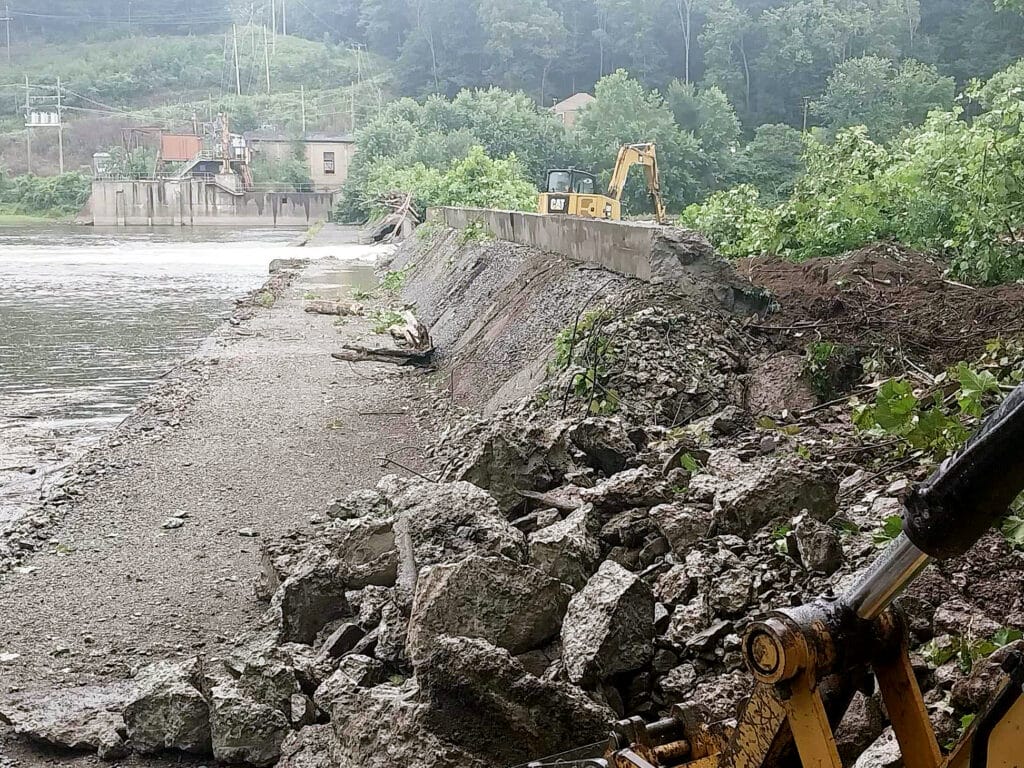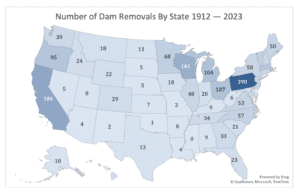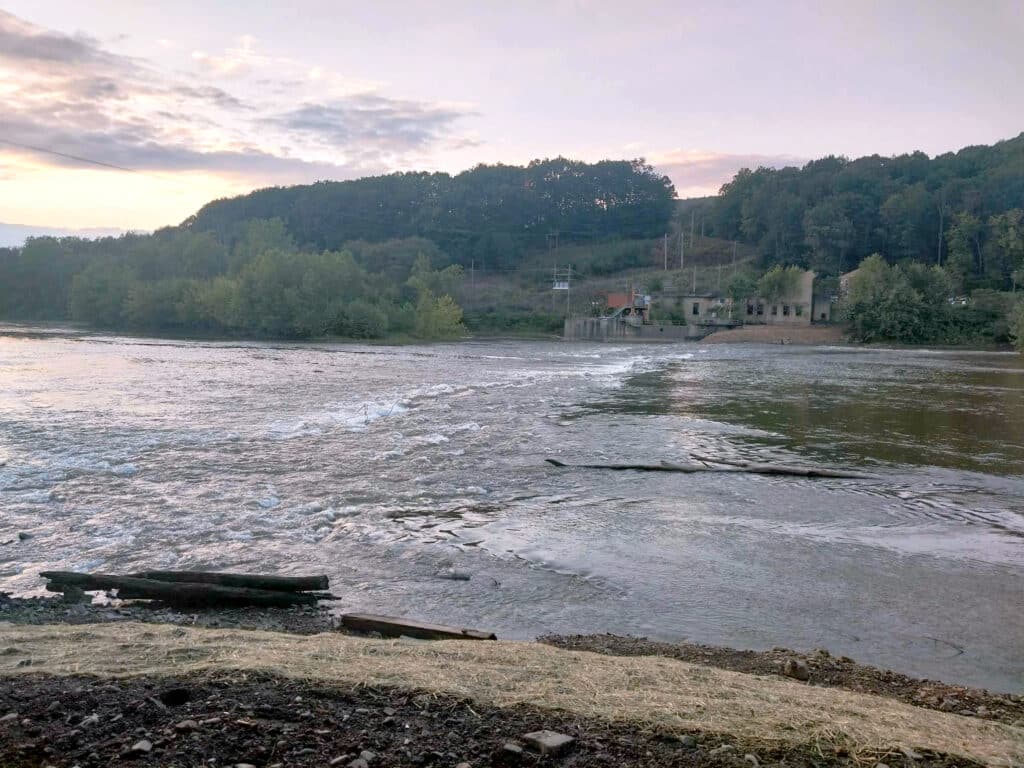Featured image credit: Cain Chamberlin
This story is part of a series exploring what’s new on Pennsylvania Water Trails, in partnership with the PA Organization for Watersheds and Rivers (POWR).
The demolition last year of a defunct damn along the North Branch Susquehanna River, in northeastern Pennsylvania, has created new paddling opportunities and expanded public access to the Water Trail.
The Oakland Dam, a former hydropower facility, was the largest dam removal project in Pennsylvania history and comes amid a recent resurgence in removals. Before its demolition, the Oakland Dam posed safety hazards and required paddlers to portage around the structure.
Improving Habitat, Reconnecting Communities
There are more than 100,000 dams in the U.S., most of which don’t serve a purpose, according to Lisa Hollingsworth-Segedy, Director of River Restoration for American Rivers, a nationwide nonprofit focused on watershed advocacy.
Pennsylvania led the nation in dam removals in 2023. Of the 80 removals last year, 15 occurred in the Commonwealth, reconnecting a total of more than 1,160 upstream river miles.

Removing unnecessary dams brings numerous ecological benefits: restoring natural processes, reestablishing migration corridors, and improving water quality, to name a few. The Oakland Dam project reconnected 250 miles of habitat for aquatic species like freshwater mussels and smallmouth bass. The U.S. Fish and Wildlife Service has been working for decades to restore migratory fish populations in the lower Susquehanna River, and officials said this brings them one step closer to accomplishing that goal.
People also benefit from these improvements. Reports have shown that every $1 million invested in restoring watersheds generates 16 jobs and up to $2.5 million in economic benefit.
The prospect of improved recreation excited leaders in Susquehanna County, who partnered with American Rivers, the Endless Mountains Heritage Region, Upper Susquehanna Coalition via Tioga County Soil & Water Conservation District, Pennsylvania Department of Environmental Protection, the PA Fish & Boat Commission, and the U.S. Army Corps of Engineers to remove the Oakland Dam.

“I am thrilled to celebrate the inspiring display of cooperation and progress between Oakland Borough and Susquehanna Depot Borough in our joint effort towards ensuring the safety, environmental sustainability, and economic growth of both of our communities,” Valerie Senese, President of the Oakland Borough Council, said in a press release.
The area has struggled to recover from deindustrialization but has found new promise in the outdoor recreation industry.
In 2021, Susquehanna County cut the ribbon on the 14-acre Ira Reynolds Riverfront Park on the site of the former Erie Rail Yard. The park is named after the longest-living Boy Scout and Susquehanna native who is remembered for his love of nature. The dam removal project includes plans to expand that park to provide camping.
Paddlers are excited by the ability to navigate that portion of the river without facing the hazardous, derelict dam. In place of the structure is a Class I rapid. Those who don’t want to maneuver the rapid have the option to take out underneath the Exchange Street Bridge on river left and put in just below the dam’s former location, about a half-mile downstream.
To celebrate, the Endless Mountains Heritage Region (EMHR) and Susquehanna Greenway Partnership (SGP) are hosting a one-day paddling sojourn on the North Branch of the Susquehanna River, starting in Oakland and taking out 12 miles downstream in Hallstead. The event has proved popular, with registration slots selling out, but a waitlist is available. To get on the list, click here.
Improving Rivers, One Dam at a Time
For decades, Pennsylvania has led the charge in dam removals. One reason is because of the state’s Division of Dam Safety under the Pennsylvania Department of Environmental Protection (DEP), which keeps careful records of dams and notifies owners know if their dam is deficient. The DEP also supports dam removal through environmental grant programs like Growing Greener.

“Just making people who own dams aware that this is an option for them and there are people and resources out there who can help them and support the cost goes a long way,” Thomas-Blate said.
American Rivers saw growing momentum around dam removal from 2017-2019, but the pandemic put a damper on the trend. Recent funding from the Bipartisan Infrastructure Law (BIL) awarded $733 million toward the rehabilitation or removal of aging dams, helping with at least 18 of this past year’s projects.
“We need more funding like this in order to address the backlog of dilapidated infrastructure out there,” Thomas-Blate wrote in a recent article.
The organization has a goal to remove 30,000 dams by 2050, pointing to the need to have funding in place for those projects once the BIL money runs out in 2026.
“That’s what we’re hoping to see is that trajectory rebounding and increase,” Thomas-Blate said.
What are water trails?
Water Trails are recreational waterways on lakes, rivers, and streams between specific destinations with access points and day-use and/or camping sites for the boating public. Pennsylvania’s Water Trails are exceptionally suited for low-impact use such as kayaking, canoeing, paddling, and floating. Each PA Water Trail is managed by a specific entity, supported by local communities, and serves to provide recreational enjoyment and stewardship opportunities. For an overview of the state’s Water Trails and map information, click here.
Pennsylvania Water Trails program
Pennsylvania’s 29 water trails link outdoor recreation and water conservation efforts. Since 2008, the Pennsylvania Environmental Council, the Pennsylvania Department of Conservation and Natural Resources, the Pennsylvania Fish and Boat Commission, and the National Parks Service have worked together to promote and maintain the Pennsylvania Water Trails Program’s network of creeks and rivers.

